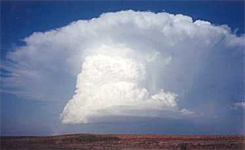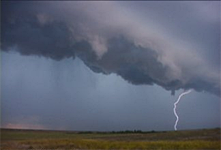Thunder & Lightening Explained |
Courtesy NWS
By definition, all thunderstorms contain lightning. Lightning is a giant spark of electricity that occurs within the atmosphere or between
the atmosphere and the ground. As lightning passes through the air, it heats the air rapidly to a temperature of about 50,000 degrees
Fahrenheit, considerably hotter than the surface of the sun. During a lightning discharge, the sudden heating of the air causes it to expand
rapidly. After the discharge, the air contracts quickly as it cools back to a normal temperature. This rapid expansion and contraction of the
air causes a shock wave that we hear as thunder (this shock wave can damage walls and break glass).
 All thunderstorms go through various stages of growth, development, electrification, and dissipation. The process of thunderstorm development
often begins early in the day when the sun heats the air near the ground and pockets of warmer air starts to rise in the atmosphere. When these
pockets reach a certain level in the atmosphere, cumulus clouds start to form. Continued heating can cause these clouds to grow vertically
upward into the atmosphere. These "towering cumulus" clouds may be one of the first indications of a developing thunderstorm. The
final stage of development occurs as the top of the cloud becomes anvil-shaped.
All thunderstorms go through various stages of growth, development, electrification, and dissipation. The process of thunderstorm development
often begins early in the day when the sun heats the air near the ground and pockets of warmer air starts to rise in the atmosphere. When these
pockets reach a certain level in the atmosphere, cumulus clouds start to form. Continued heating can cause these clouds to grow vertically
upward into the atmosphere. These "towering cumulus" clouds may be one of the first indications of a developing thunderstorm. The
final stage of development occurs as the top of the cloud becomes anvil-shaped.
As the cloud grows, precipitation forms within the cloud with mostly ice crystals in the upper levels of the cloud, a mixture of ice crystals and hail at the middle levels of the cloud, and a mixture of rain and melting hail in the lower levels of the cloud. Due to air movements and collisions between the precipitation particles near the middle of the cloud, the various precipitation particles become charged. The lighter ice crystals gather a positive charge and are carried upward into the upper part of the storm by the updraft. The heavier hail gathers a negative charge and falls toward the lower part of the storm. The end result is that the top of the cloud becomes positively charged and the lower part of the storm becomes negatively charged.
Normally, the earth's surface has a slight negative charge; however, as the negative charges build up in the lower part of the storm, the ground beneath the base of the cloud and in the area immediately surrounding the cloud becomes positively charged. As the cloud moves, these induced positive charges on the ground follow the cloud like a shadow. Farther away from the cloud base, but under the positively charged anvil, the negative charge may be further induced.
In the initial stages of development, air acts as an insulator between the positive and negative charges. However, when the electrical potential between the positive and negative charges becomes too great, there is a discharge of electricity that we know and see as lightning.
Lightning can occur completely within the thunderstorm cloud or between the cloud and the ground. In-cloud lightning generally occurs between positive charges near the top of the cloud and negative charges near the bottom of the cloud. Cloud-to-ground lightning occurs between the cloud and the ground and is, of course, the most dangerous. Lightning can also occur between different clouds.
Cloud-to-ground lightning can be categorized into two different types -- the negative flash and the positive flash. The negative flash usually occurs between the negative charges in the lower part of the storm and the positive charges on the ground under and near the cloud base. Positive flashes usually occur between the positively-charged upper levels of the storm and the negatively-charged area surrounding the storm.
In the negative cloud-to-ground flash, an almost invisible, negatively-charged channel of air forms near the cloud base and surges downward toward the ground. As this "step leader" approaches the ground, streamers of positive charge shoot upward from trees, buildings, and other objects on the ground. When these streamers meet the step leader, the connection is complete, and a surge of electrical current moves from the ground to the cloud causing the visible "return stroke" that we call lightning. The entire process takes only a matter of a seconds.
The process for a positive flash is similar except that a positive channel usually originates in the anvil of the storm and surges downward. In this case, streamers of negative charge shoot up to meet positively-charged channel as it approaches the ground. When a connection is made, a positive flash of lightning occurs.
While both negative and positive flashes of lightning can be deadly, the positive flashes generally are more destructive and are more apt to catch people by surprise. Because the distance between the ground and anvil is much greater than the distance between the ground and the cloud base, a much larger electric potential is needed to initiate a positive flash of lightning. For the same reason, positive flashes are infrequent and widely scattered around the storm, but generally involve the exchange of a much greater charge and are usually more destructive.
 The greatest danger associated with the positive flashes, however, is that they strike in areas where most people think they are safe from the
storm. They generally strike well beyond the area where rain is falling and well beyond the main area where most of the lightning (negative
flashes) and thunder is occurring. Consequently, many victims are caught completely off guard.
The greatest danger associated with the positive flashes, however, is that they strike in areas where most people think they are safe from the
storm. They generally strike well beyond the area where rain is falling and well beyond the main area where most of the lightning (negative
flashes) and thunder is occurring. Consequently, many victims are caught completely off guard.
The best advice in order to minimize your risk of becoming a lightning victim is to get to a safe shelter sooner and to stay there longer. In general, if you can hear thunder, you are within striking distance of the storm.
LIGHTNING FACT: What is often referred to as "HEAT LIGHTNING" is simply the lightning from a distant thunderstorm that is too far away for the resultant thunder to be heard. In most cases, the light you observe is being reflected off clouds near the horizon. Keep an eye on the storm though, since it may be headed in your direction.
LIGHTNING QUESTION:
How can you tell how far a flash of lightning is away from you?
ANSWER:
While you see the visible flash of lightning almost instantaneously, the sound of the thunder travels at a speed of about 1100 feet per second or about 1 mile in 5 seconds. For every 5 seconds between the time you observe the lightning and the time you hear the thunder, the lightning flash is 1 mile away. If it takes 10 seconds between the lightning flash and the thunder, the lightning flash was 2 miles away. For 15 seconds, the flash would be three miles away. Unfortunately, this method only works for the previous flash and does not tell you how close the next lightning strike will be. Generally, if you hear thunder, you are within striking distance for the next flash of lightning. If you are not in a safe place at the time, move to a safe place immediately.
 All thunderstorms go through various stages of growth, development, electrification, and dissipation. The process of thunderstorm development
often begins early in the day when the sun heats the air near the ground and pockets of warmer air starts to rise in the atmosphere. When these
pockets reach a certain level in the atmosphere, cumulus clouds start to form. Continued heating can cause these clouds to grow vertically
upward into the atmosphere. These "towering cumulus" clouds may be one of the first indications of a developing thunderstorm. The
final stage of development occurs as the top of the cloud becomes anvil-shaped.
All thunderstorms go through various stages of growth, development, electrification, and dissipation. The process of thunderstorm development
often begins early in the day when the sun heats the air near the ground and pockets of warmer air starts to rise in the atmosphere. When these
pockets reach a certain level in the atmosphere, cumulus clouds start to form. Continued heating can cause these clouds to grow vertically
upward into the atmosphere. These "towering cumulus" clouds may be one of the first indications of a developing thunderstorm. The
final stage of development occurs as the top of the cloud becomes anvil-shaped.As the cloud grows, precipitation forms within the cloud with mostly ice crystals in the upper levels of the cloud, a mixture of ice crystals and hail at the middle levels of the cloud, and a mixture of rain and melting hail in the lower levels of the cloud. Due to air movements and collisions between the precipitation particles near the middle of the cloud, the various precipitation particles become charged. The lighter ice crystals gather a positive charge and are carried upward into the upper part of the storm by the updraft. The heavier hail gathers a negative charge and falls toward the lower part of the storm. The end result is that the top of the cloud becomes positively charged and the lower part of the storm becomes negatively charged.
Normally, the earth's surface has a slight negative charge; however, as the negative charges build up in the lower part of the storm, the ground beneath the base of the cloud and in the area immediately surrounding the cloud becomes positively charged. As the cloud moves, these induced positive charges on the ground follow the cloud like a shadow. Farther away from the cloud base, but under the positively charged anvil, the negative charge may be further induced.
In the initial stages of development, air acts as an insulator between the positive and negative charges. However, when the electrical potential between the positive and negative charges becomes too great, there is a discharge of electricity that we know and see as lightning.
Lightning can occur completely within the thunderstorm cloud or between the cloud and the ground. In-cloud lightning generally occurs between positive charges near the top of the cloud and negative charges near the bottom of the cloud. Cloud-to-ground lightning occurs between the cloud and the ground and is, of course, the most dangerous. Lightning can also occur between different clouds.
Cloud-to-ground lightning can be categorized into two different types -- the negative flash and the positive flash. The negative flash usually occurs between the negative charges in the lower part of the storm and the positive charges on the ground under and near the cloud base. Positive flashes usually occur between the positively-charged upper levels of the storm and the negatively-charged area surrounding the storm.
In the negative cloud-to-ground flash, an almost invisible, negatively-charged channel of air forms near the cloud base and surges downward toward the ground. As this "step leader" approaches the ground, streamers of positive charge shoot upward from trees, buildings, and other objects on the ground. When these streamers meet the step leader, the connection is complete, and a surge of electrical current moves from the ground to the cloud causing the visible "return stroke" that we call lightning. The entire process takes only a matter of a seconds.
The process for a positive flash is similar except that a positive channel usually originates in the anvil of the storm and surges downward. In this case, streamers of negative charge shoot up to meet positively-charged channel as it approaches the ground. When a connection is made, a positive flash of lightning occurs.
While both negative and positive flashes of lightning can be deadly, the positive flashes generally are more destructive and are more apt to catch people by surprise. Because the distance between the ground and anvil is much greater than the distance between the ground and the cloud base, a much larger electric potential is needed to initiate a positive flash of lightning. For the same reason, positive flashes are infrequent and widely scattered around the storm, but generally involve the exchange of a much greater charge and are usually more destructive.
 The greatest danger associated with the positive flashes, however, is that they strike in areas where most people think they are safe from the
storm. They generally strike well beyond the area where rain is falling and well beyond the main area where most of the lightning (negative
flashes) and thunder is occurring. Consequently, many victims are caught completely off guard.
The greatest danger associated with the positive flashes, however, is that they strike in areas where most people think they are safe from the
storm. They generally strike well beyond the area where rain is falling and well beyond the main area where most of the lightning (negative
flashes) and thunder is occurring. Consequently, many victims are caught completely off guard.The best advice in order to minimize your risk of becoming a lightning victim is to get to a safe shelter sooner and to stay there longer. In general, if you can hear thunder, you are within striking distance of the storm.
LIGHTNING FACT: What is often referred to as "HEAT LIGHTNING" is simply the lightning from a distant thunderstorm that is too far away for the resultant thunder to be heard. In most cases, the light you observe is being reflected off clouds near the horizon. Keep an eye on the storm though, since it may be headed in your direction.
LIGHTNING QUESTION:
How can you tell how far a flash of lightning is away from you?
ANSWER:
While you see the visible flash of lightning almost instantaneously, the sound of the thunder travels at a speed of about 1100 feet per second or about 1 mile in 5 seconds. For every 5 seconds between the time you observe the lightning and the time you hear the thunder, the lightning flash is 1 mile away. If it takes 10 seconds between the lightning flash and the thunder, the lightning flash was 2 miles away. For 15 seconds, the flash would be three miles away. Unfortunately, this method only works for the previous flash and does not tell you how close the next lightning strike will be. Generally, if you hear thunder, you are within striking distance for the next flash of lightning. If you are not in a safe place at the time, move to a safe place immediately.










